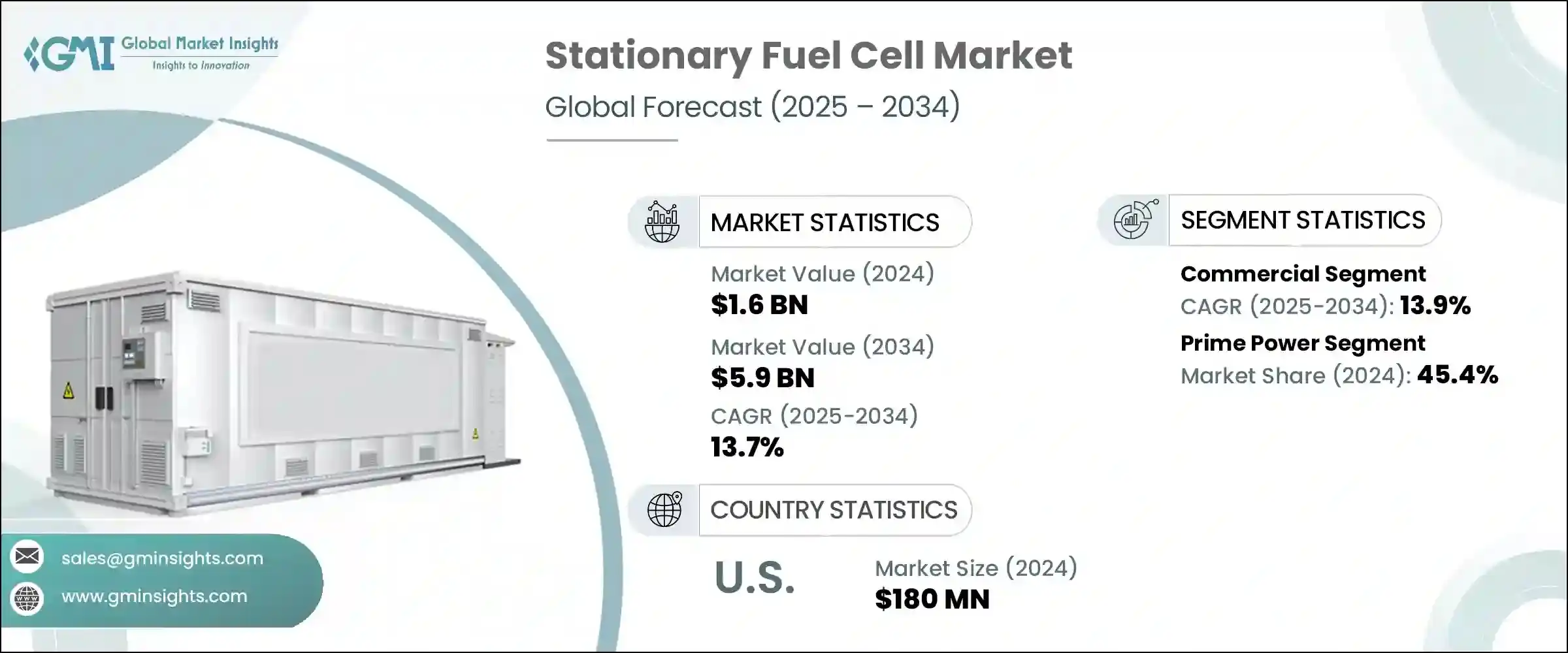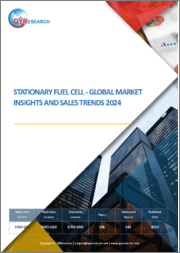
|
시장보고서
상품코드
1773215
고정형 연료전지 시장 기회, 성장 촉진요인, 산업 동향 분석, 예측(2025-2034년)Stationary Fuel Cell Market Opportunity, Growth Drivers, Industry Trend Analysis, and Forecast 2025 - 2034 |
||||||
세계의 고정형 연료전지 시장은 2024년에 16억 달러로 평가되며, CAGR 13.7%로 성장하며, 2034년에는 59억 달러에 달할 것으로 추정되고 있습니다.
이러한 연료전지는 안정적이고 신뢰할 수 있는 전력을 공급하므로 상설 설치에 적합합니다. 연료전지 기술의 유형에 따라 수소, 바이오가스, 천연가스 등 다양한 연료로 작동할 수 있습니다. 소형 및 대용량 연료전지 시스템에 대한 수요 증가와 공공 및 민간 부문의 수소 인프라에 대한 투자로 인해 시장 성장이 촉진될 것으로 예측됩니다.

기업이 신뢰할 수 있는 청정 에너지 솔루션을 찾고 있는 가운데, 연료전지는 전력망에 대한 의존도를 줄이고 에너지 안보를 강화하기 위해 중요 지역에 전력을 공급하는 데 점점 더 많이 사용되고 있습니다. 이러한 시스템은 최소한의 배출로 중단 없는 전력 공급을 제공하므로 가동 중단이 큰 운영 손실로 이어질 수 있는 산업에 이상적입니다. 또한 확장성과 유연성으로 인해 데이터센터와 병원부터 원격지 시설 및 제조 산업의 백업 전원에 이르기까지 다양한 용도에 통합할 수 있습니다. 또한 지속가능성 목표가 강화되고 이산화탄소 감축 목표가 더욱 엄격해짐에 따라 연료전지 기술로의 전환은 보다 광범위한 환경 및 규제 의무에 부합합니다. 이러한 전환은 공공 및 민간 부문의 투자와 혁신을 촉진하여 전 세계에서 연료전지 채택을 더욱 가속화하고 있습니다.
| 시장 범위 | |
|---|---|
| 시작연도 | 2024년 /td> |
| 예측연도 | 2025-2034년 |
| 시작 금액 | 16억 달러 |
| 예측 금액 | 59억 달러 |
| CAGR | 13.7% |
주거용 부문은 2034년까지 22억 달러 이상에 달할 것으로 추정되며, 주거 환경의 소형화 및 저소음 전원에 대한 수요 증가로 인해 더욱 강화될 것으로 예측됩니다. 이러한 특성으로 인해 고정형 연료전지는 교외 및 도시 주택에서 신뢰할 수 있고 컴팩트한 에너지 솔루션으로 매우 효율적일 수 있습니다. 또한 에너지 독립성, 지속가능성 및 청정 에너지의 이점에 대한 소비자의 인식은 산업 확장의 원동력이 될 것입니다.
CHP 부문은 2034년까지 9억 달러 이상 시장 규모에 달할 것으로 추정됩니다. 2024년 2월, Scale Microgrids는 코네티컷 주 브리지포트에서 9.6MW 규모의 CHP 연료전지 프로젝트를 인수했으며, 이 프로젝트는 1.6마일의 열루프를 포함하며 HyAxiom이 제조 및 운영할 예정입니다. 이 프로젝트에는 1.6마일의 열 루프가 포함되며 HyAxiom이 제조 및 운영할 예정입니다. 또한 산업용 공정 열에 대한 수요 증가가 제품 출시에 영향을 미칠 것으로 예측됩니다.
아시아태평양의 고정형 연료전지 시장은 2034년까지 48억 달러에 달할 것으로 예측됩니다. 중국과 인도를 포함한 국가의 급속한 도시화는 연료전지 채택을 촉진할 것으로 예측됩니다. 또한 아시아태평양의 주요 제조 거점들은 산업계가 고출력 요구 사항을 충족하기 위해 비용 효율적이고 효율적이며 지속가능한 에너지 솔루션을 점점 더 많이 찾고 있으며, 이는 이 지역의 고정형 연료전지 보급을 더욱 가속화하여 시장 성장을 가속할 것으로 예측됩니다.
고정형 연료전지 업계에서 사업을 운영하고 있는 주요 기업은 Altergy, AFC Energy, Bloom Energy, Ballard Power Systems, Cummins, Doosan Fuel Cell, Fuji Electric, Fuel Cell Energy, GenCell, poscoenergy, Plug Power, Nuvera Fuel Cells, Siemens Energy, SFC Energy, Toshiba Corporation 등이 있습니다.
목차
제1장 조사 방법과 범위
제2장 개요
제3장 업계 인사이트
- 업계 에코시스템
- 규제 상황
- 업계에 대한 영향요인
- 촉진요인
- 업계의 잠재적 리스크·과제
- 성장 가능성 분석
- Porter의 산업 분석
- PESTEL 분석
제4장 경쟁 구도
- 서론
- 기업의 시장 점유율
- 전략적 대시보드
- 전략적 구상
- 경쟁 벤치마킹
- 혁신과 테크놀러지의 상황
제5장 시장 규모·예측 : 용량별, 2021-2034년
- 주요 동향
- 3kW 미만
- 3-10kW
- 10-50kW 이상
- 50kW 이상
제6장 시장 규모·예측 : 용도별, 2021-2034년
- 주요 동향
- 프라임 파워
- CHP
- 기타
제7장 시장 규모·예측 : 최종 용도별, 2021-2034년
- 주요 동향
- 주택
- 상업
- 산업/유틸리티
제8장 시장 규모·예측 : 지역별, 2021-2034년
- 주요 동향
- 북미
- 미국
- 캐나다
- 유럽
- 독일
- 영국
- 프랑스
- 이탈리아
- 스페인
- 오스트리아
- 아시아태평양
- 일본
- 한국
- 중국
- 인도
- 필리핀
- 베트남
- 중동 및 아프리카
- 남아프리카공화국
- 사우디아라비아
- 아랍에미리트
- 라틴아메리카
- 브라질
- 페루
- 멕시코
제9장 기업 개요
- Altergy
- AFC Energy
- Bloom Energy
- Ballard Power Systems
- Cummins
- Doosan Fuel Cell
- Fuji Electric
- Fuel Cell Energy
- GenCell
- poscoenergy
- Plug Power
- Nuvera Fuel Cells
- Siemens Energy
- SFC Energy
- Toshiba Corporation
The Global Stationary Fuel Cell Market was valued at USD 1.6 billion in 2024 and is estimated to grow at a CAGR of 13.7% to reach USD 5.9 billion by 2034. These fuel cells provide a stable and dependable electricity source, making them ideal for permanent installations. They can run on various fuels, such as hydrogen, biogas, or natural gas, depending on the type of fuel cell technology. The rising demand for both small and large-capacity fuel cell systems, along with investments in hydrogen infrastructure by both public and private sectors, will likely boost market growth.

As businesses seek reliable and clean energy solutions, fuel cells are increasingly used to provide power in critical areas, reducing grid dependence and enhancing energy security. These systems offer uninterrupted power supply with minimal emissions, making them ideal for industries where downtime can lead to significant operational losses. Their scalability and flexibility also allow integration across a wide range of applications-from data centers and hospitals to remote facilities and backup power in manufacturing. Moreover, as sustainability goals tighten and carbon reduction targets become more stringent, the shift toward fuel cell technology aligns with broader environmental and regulatory mandates. This transition is driving investment and innovation across both public and private sectors, further accelerating fuel cell adoption globally.
| Market Scope | |
|---|---|
| Start Year | 2024 |
| Forecast Year | 2025-2034 |
| Start Value | $1.6 Billion |
| Forecast Value | $5.9 Billion |
| CAGR | 13.7% |
The residential segment is estimated to reach over USD 2.2 billion by 2034, augmented by the growing need for smaller sizes and lower noise-level power sources in the residential environment. These features make stationary fuel cells highly efficient for suburban and urban residences in the form of reliable and compact energy solutions. Additionally, consumer awareness about energy independence, sustainability, and the benefits of clean energy will drive the industry expansion.
The CHP segment is estimated to be worth more than USD 0.9 billion by 2034, owing to the great thermal efficiency of fuel cell systems that generate power and heat together, maximizing the energy utilization and reducing losses. In February 2024, Scale Microgrids acquired a 9.6 MW CHP fuel cell project in Bridgeport, Connecticut, which includes a 1.6-mile thermal loop and will be fabricated and operated by HyAxiom. Moreover, growing demand for industrial process heat will influence product deployment.
Asia Pacific stationary fuel cell market is projected to hit USD 4.8 billion by 2034. Rapid urbanization in countries including China and India is expected to stimulate fuel cell adoption. Additionally, Asia Pacific's major manufacturing hubs will foster substantial market growth as industries increasingly seek cost-effective, efficient, and sustainable energy solutions to meet their high-power requirements, further accelerating stationary fuel cell deployment in the region.
Eminent players operating in the stationary fuel cell industry are Altergy, AFC Energy, Bloom Energy, Ballard Power Systems, Cummins, Doosan Fuel Cell, Fuji Electric, Fuel Cell Energy, GenCell, poscoenergy, Plug Power, Nuvera Fuel Cells, Siemens Energy, SFC Energy, and Toshiba Corporation.
Table of Contents
Chapter 1 Methodology & Scope
- 1.1 Research design
- 1.2 Base estimates & calculations
- 1.3 Forecast calculation
- 1.4 Primary research & validation
- 1.4.1 Primary sources
- 1.4.2 Data mining sources
- 1.5 Market definitions
Chapter 2 Executive Summary
- 2.1 Industry synopsis, 2021 - 2034
Chapter 3 Industry Insights
- 3.1 Industry ecosystem
- 3.2 Regulatory landscape
- 3.3 Industry impact forces
- 3.3.1 Growth drivers
- 3.3.2 Industry pitfalls & challenges
- 3.4 Growth potential analysis
- 3.5 Porter's analysis
- 3.5.1 Bargaining power of suppliers
- 3.5.2 Bargaining power of buyers
- 3.5.3 Threat of new entrants
- 3.5.4 Threat of substitutes
- 3.6 PESTEL analysis
Chapter 4 Competitive landscape, 2025
- 4.1 Introduction
- 4.2 Company market share, 2024
- 4.3 Strategic dashboard
- 4.4 Strategic initiative
- 4.5 Competitive benchmarking
- 4.6 Innovation & technology landscape
Chapter 5 Market Size and Forecast, By Capacity, 2021 - 2034 (USD Million & MW)
- 5.1 Key trends
- 5.2 < 3 kW
- 5.3 3 - 10 kW
- 5.4 >10 - 50 kW
- 5.5 >50 kW
Chapter 6 Market Size and Forecast, By Application, 2021 - 2034 (USD Million & MW)
- 6.1 Key trends
- 6.2 Prime power
- 6.3 CHP
- 6.4 Others
Chapter 7 Market Size and Forecast, By End Use, 2021 - 2034 (USD Million & MW)
- 7.1 Key trends
- 7.2 Residential
- 7.3 Commercial
- 7.4 Industry/utility
Chapter 8 Market Size and Forecast, By Region, 2021 - 2034 (USD Million & MW)
- 8.1 Key trends
- 8.2 North America
- 8.2.1 U.S.
- 8.2.2 Canada
- 8.3 Europe
- 8.3.1 Germany
- 8.3.2 UK
- 8.3.3 France
- 8.3.4 Italy
- 8.3.5 Spain
- 8.3.6 Austria
- 8.4 Asia Pacific
- 8.4.1 Japan
- 8.4.2 South Korea
- 8.4.3 China
- 8.4.4 India
- 8.4.5 Philippines
- 8.4.6 Vietnam
- 8.5 Middle East & Africa
- 8.5.1 South Africa
- 8.5.2 Saudi Arabia
- 8.5.3 UAE
- 8.6 Latin America
- 8.6.1 Brazil
- 8.6.2 Peru
- 8.6.3 Mexico
Chapter 9 Company Profiles
- 9.1 Altergy
- 9.2 AFC Energy
- 9.3 Bloom Energy
- 9.4 Ballard Power Systems
- 9.5 Cummins
- 9.6 Doosan Fuel Cell
- 9.7 Fuji Electric
- 9.8 Fuel Cell Energy
- 9.9 GenCell
- 9.10 poscoenergy
- 9.11 Plug Power
- 9.12 Nuvera Fuel Cells
- 9.13 Siemens Energy
- 9.14 SFC Energy
- 9.15 Toshiba Corporation

















